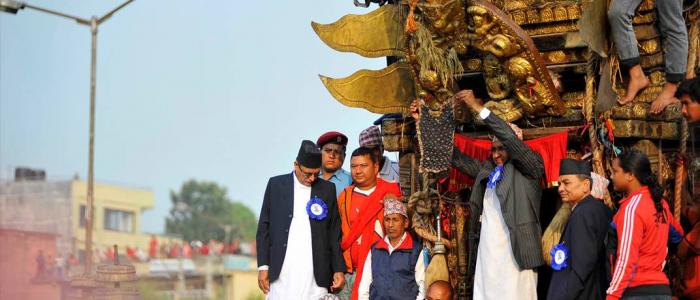Bhoto Jatra
- Jawalakhel, Lalitpur

Showing the vest to the crowds on Bhoto Jatra Bhoto Jatra, which literally means “vest festival”, is the climax of the chariot procession of Bunga Dyah Jatra. As per Nepal Bhasa the Jatra should be considered as Pwaklo Jatra because Pwaklo refers to Vest while Bhoto has sleeves.
After the two chariots arrive in Jawalakhel, astrologers choose an auspicious date to hold the Bhoto Jatra festival. On the appointed day in the presence of the head of state, a government official climbs on to the chariot and holds up a jewel-studded black vest from the four sides of the chariot so that all the people gathered around can have a look at it.
The display is a re-enactment of an event that happened eons ago. According to legend, a Jyapu (Newar farmer) lost the vest which he had received as a gift from the serpent god Karkotaka Naga for doing him a favour. There are two legends of the favor one of them being the Jyapu providing him some ayurvedic herbs by examining the ill wife of Karkotaka Naga which healed her. Another legend says that the Jayapu was frightened when Karkotaka Naga asked for some herbs to cure his ill wife so the Jyapu who didn’t had any idea regarding herbs gave him his own ‘khiti'(dirts from his sweaty body) that healed her.
One day, the farmer had come to Jawalakhel to watch the chariot pulling festival where he saw someone wearing his missing garment. A quarrel developed over the vest, and since neither party could prove ownership, it was agreed that the undershirt would be kept with Bunga Dyah until the rightful owner comes to claim it with adequate proof. Since then, the vest has been shown to the public annually as a call to potential claimants to step forward.
The living goddess Kumari of Patan also arrives in Jawalakhel to observe Bhoto Jatra. She watches the ceremony from a special rest house.The auspicious day when the Bhoto Jatra is held is determined by astrologers, so the date is changeable. In 2014, the vest showing will be held on 22 June.
After the festival, the chariot is dismantled and the parts are stored until it is time for the procession the next year. Rato Machhendranath is taken to a temple in the nearby village of Bungamati, also known as the second home of the rain god. The deity spends the next six months in that temple.
info Source: wikipedia